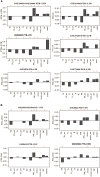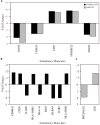Meta-Analysis Identification of Highly Robust and Differential Immune-Metabolic Signatures of Systemic Host Response to Acute and Latent Tuberculosis in Children and Adults
- PMID: 30337941
- PMCID: PMC6180280
- DOI: 10.3389/fgene.2018.00457
Meta-Analysis Identification of Highly Robust and Differential Immune-Metabolic Signatures of Systemic Host Response to Acute and Latent Tuberculosis in Children and Adults
Abstract
Background: Whole blood expression profiling is a mainstay for delineating differential diagnostic signatures of infection yet is subject to high variability that reduces power and complicates clinical usefulness. To date, confirmatory high confidence expression profiling signatures for clinical use remain uncertain. Here we have sought to evaluate the reproducibility and confirmatory nature of differential expression signatures, comprising molecular and cellular pathways, across multiple international clinical observational studies investigating children and adult whole blood transcriptome responses to tuberculosis (TB). Methods and findings: A systematic search and quality control assessment of gene expression repositories for human TB using whole blood resulted in 11 datasets with a total of 1073 patients from Africa, Europe, and South America. A non-parametric estimation of percentage of false prediction was used for meta-analysis of high confidence differential expression analysis. Deconvolution analysis was applied to infer changes in immune cell proportions and enrichment tests applied using pathway database resources. Meta-analysis identified high confidence differentially expressed genes, comprising 372 in adult active-TB versus latent-TB (LTBI), 332 in adult active-TB versus controls (CON), five in LTBI versus CON, and 415 in childhood active-TB versus LTBI. Notably, these confirmatory markers have low representation in published signatures for diagnosing TB. Pathway biology analysis of high confidence gene sets revealed dominant metabolic and innate-immune pathway signatures while suppressed signatures were enriched with adaptive signaling pathways and reduced proportions of T and B cells. Childhood TB showed uniquely strong inflammasome antagonist signature (IL1RN and ILR2), while adult TB patients exhibit a significant preponderance type I and type II IFN markers. Key limitations of the study include the paucity of data on potential confounders. Conclusion: Meta-analysis identified high confidence confirmatory immune-metabolic and cellular expression signatures across studies regardless of the population resource setting, HIV status and circulating endemic pathogens. Notably, previously identified diagnostic signature markers for TB show limited concordance with the confirmatory meta-analysis. Overall, our results support the use of the confirmatory expression signatures for guiding optimized diagnostic, prognostic, and therapeutic monitoring modalities in TB.
Keywords: bioinformatics; immunity; meta-analysis; microarray; systemic responses; tuberculosis.
Figures









Similar articles
-
Detection of tuberculosis in HIV-infected and -uninfected African adults using whole blood RNA expression signatures: a case-control study.PLoS Med. 2013 Oct;10(10):e1001538. doi: 10.1371/journal.pmed.1001538. Epub 2013 Oct 22. PLoS Med. 2013. PMID: 24167453 Free PMC article.
-
Host-response-based gene signatures for tuberculosis diagnosis: A systematic comparison of 16 signatures.PLoS Med. 2019 Apr 23;16(4):e1002786. doi: 10.1371/journal.pmed.1002786. eCollection 2019 Apr. PLoS Med. 2019. PMID: 31013272 Free PMC article.
-
Folic acid supplementation and malaria susceptibility and severity among people taking antifolate antimalarial drugs in endemic areas.Cochrane Database Syst Rev. 2022 Feb 1;2(2022):CD014217. doi: 10.1002/14651858.CD014217. Cochrane Database Syst Rev. 2022. PMID: 36321557 Free PMC article.
-
Transcriptional Profiling and Deriving a Seven-Gene Signature That Discriminates Active and Latent Tuberculosis: An Integrative Bioinformatics Approach.Genes (Basel). 2022 Mar 29;13(4):616. doi: 10.3390/genes13040616. Genes (Basel). 2022. PMID: 35456421 Free PMC article.
-
Screening of potential biomarkers for distinguishing between latent and active tuberculosis in children using bioinformatics analysis.Medicine (Baltimore). 2021 Feb 5;100(5):e23207. doi: 10.1097/MD.0000000000023207. Medicine (Baltimore). 2021. PMID: 33592820 Free PMC article.
Cited by
-
Gene signature discovery and systematic validation across diverse clinical cohorts for TB prognosis and response to treatment.PLoS Comput Biol. 2023 Jul 20;19(7):e1010770. doi: 10.1371/journal.pcbi.1010770. eCollection 2023 Jul. PLoS Comput Biol. 2023. PMID: 37471455 Free PMC article.
-
Immune Subtyping in Latent Tuberculosis.Front Immunol. 2021 Apr 7;12:595746. doi: 10.3389/fimmu.2021.595746. eCollection 2021. Front Immunol. 2021. PMID: 33897680 Free PMC article.
-
A blood RNA transcript signature for TB exposure in household contacts.BMC Infect Dis. 2020 Jun 9;20(1):403. doi: 10.1186/s12879-020-05116-1. BMC Infect Dis. 2020. PMID: 32517725 Free PMC article.
-
Successful treatment of life-threatening mycobacteriosis using adjunctive gamma-interferon therapy with genetic analysis.IJTLD Open. 2024 Jan 1;1(1):56-58. doi: 10.5588/ijtldopen.23.0406. eCollection 2024 Jan. IJTLD Open. 2024. PMID: 38919412 Free PMC article. No abstract available.
-
Novel functional sequences uncovered through a bovine multiassembly graph.Proc Natl Acad Sci U S A. 2021 May 18;118(20):e2101056118. doi: 10.1073/pnas.2101056118. Proc Natl Acad Sci U S A. 2021. PMID: 33972446 Free PMC article.
References
-
- Abbas A. R., Baldwin D., Ma Y., Ouyang W., Gurney A., Martin F., et al. (2005). Immune response in silico (IRIS): immune-specific genes identified from a compendium of microarray expression data. Genes Immun. 6 319–331. - PubMed
Grants and funding
LinkOut - more resources
Full Text Sources

